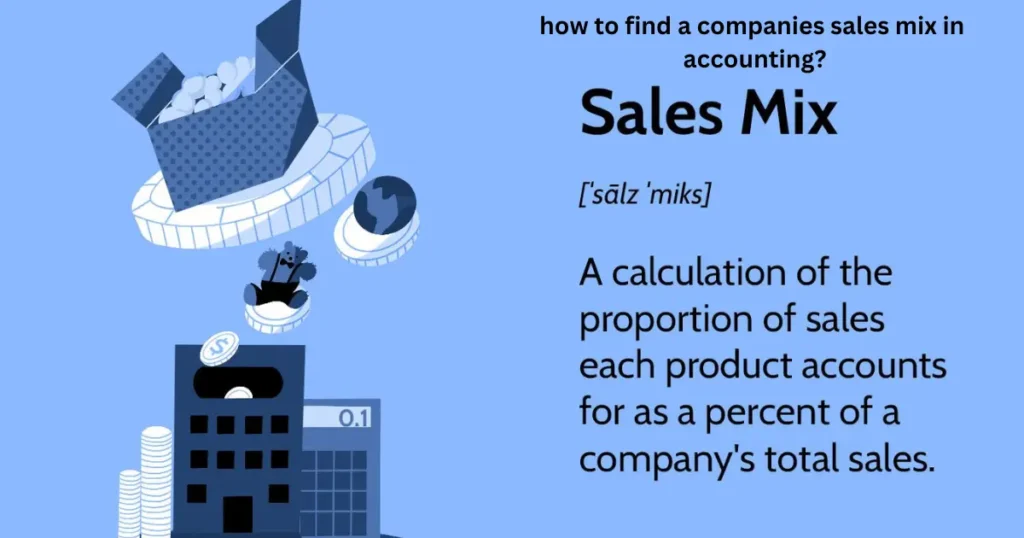Understanding a company’s sales mix is crucial for business success. It tells you the proportion of each product or service that contributes to total sales revenue.
This information helps businesses make informed decisions about pricing, production, and marketing. This guide will walk you through the process of calculating and interpreting a company’s sales mix, using simple language and practical examples.
What is Sales Mix and Why is it Important?
Sales mix represents the relative proportion of each product or service sold by a company. It’s expressed as a percentage of total sales. For example, if a company sells two products, A and B, and the sales mix is 60% for A and 40% for B, it means that for every $100 of sales, $60 comes from product A and $40 from product B.
Understanding the sales mix is important because it:
- Impacts Profitability: Different products have different profit margins. Knowing the sales mix helps identify which products are most profitable and contribute the most to overall profit.
- Influences Inventory Management: A good understanding of the sales mix allows businesses to optimize their inventory levels. You can ensure you have enough of the fast-moving products and avoid overstocking slower-moving ones.
- Guides Marketing Strategies: The sales mix can inform marketing efforts. If a company wants to increase sales of a particular product, they can target their marketing campaigns accordingly.
- Aids in Pricing Decisions: Knowing the sales mix can help businesses make better pricing decisions. They may choose to lower the price of a slow-moving product to increase sales or raise the price of a popular product to maximize profit.
- Facilitates Forecasting: Sales mix data is essential for accurate sales forecasting. By understanding the historical sales mix, businesses can make better predictions about future sales.
How to Calculate Sales Mix in Accounting
Calculating the sales mix is straightforward. Here’s the step-by-step process:
- Gather Sales Data: Collect the sales data for each product or service for a specific period (e.g., monthly, quarterly, annually). This data should include the number of units sold and the selling price per unit.
- Calculate Total Sales Revenue: Multiply the number of units sold by the selling price per unit for each product to get the sales revenue for that product. Then, add up the sales revenue for all products to get the total sales revenue.
- Calculate Sales Revenue for Each Product: For each product, calculate its sales revenue. This is done by multiplying the number of units sold of that product by its selling price per unit.
- Calculate the Sales Mix Percentage: For each product, divide its sales revenue by the total sales revenue and multiply by 100 to get the sales mix percentage.
Here’s the formula:
Sales Mix Percentage = (Sales Revenue of Product / Total Sales Revenue) * 100
Example of Sales Mix Calculation
Let’s say a company sells two products: Product X and Product Y. Here’s the sales data:
| Product | Units Sold | Selling Price per Unit | Sales Revenue |
|---|---|---|---|
| X | 1,000 | $20 | $20,000 |
| Y | 500 | $30 | $15,000 |
| Total | $35,000 |
Now, let’s calculate the sales mix percentage for each product:
Product X: ($20,000 / $35,000) * 100 = 57.14%
Product Y: ($15,000 / $35,000) * 100 = 42.86%
This means that Product X contributes 57.14% to the company’s total sales revenue, while Product Y contributes 42.86%.
Analyzing the Sales Mix
Once you’ve calculated the sales mix, you can analyze it to gain valuable insights. Here are some things to consider:
- Changes Over Time: Track the sales mix over different periods to identify trends. Are certain products becoming more or less popular? This can help you anticipate changes in demand and adjust your strategies accordingly.
- Contribution to Profit: As mentioned earlier, different products have different profit margins. Calculate the profit margin for each product and see how it relates to the sales mix. This will help you identify which products are most profitable.
- External Factors: Consider how external factors, such as economic conditions, competitor activity, and seasonal changes, might be affecting the sales mix.
Using Sales Mix for Business Decisions
The sales mix is a powerful tool that can be used to make better business decisions. Here are some examples:
- Pricing Strategies: If a product with a low profit margin has a high sales mix percentage, you might consider raising the price slightly to improve profitability.
- Marketing Campaigns: If you want to increase sales of a particular product, you can target your marketing campaigns towards that product.
- Production Planning: The sales mix can help you plan your production schedule. You can produce more of the products that have a high sales mix percentage and less of the products that have a low sales mix percentage.
- Inventory Control: By understanding the sales mix, you can optimize your inventory levels. You can keep more stock of fast-moving products and less stock of slow-moving products.
Sales Mix Variance Analysis
Sales mix variance analysis helps businesses understand how changes in the sales mix affect their overall profitability. It compares the actual sales mix to the budgeted sales mix and identifies any variances. This analysis can help businesses identify areas where they need to make adjustments to their strategies.
Sales Mix and Break-Even Analysis
The sales mix is an important factor to consider when performing break-even analysis. The break-even point is the level of sales at which a business neither makes a profit nor incurs a loss. The sales mix affects the overall break-even point because different products have different contribution margins (selling price per unit minus variable cost per unit).
Example of Sales Mix Variance Analysis
Let’s say a company budgeted to sell Product A and Product B in a certain proportion. The actual sales mix turned out to be different. Sales mix variance analysis helps determine how this difference impacted the overall profit.
| Product | Budgeted Sales Mix | Actual Sales Mix |
|---|---|---|
| A | 60% | 50% |
| B | 40% | 50% |
This table shows that Product A performed worse than expected, while Product B performed better. The sales mix variance analysis would then calculate the impact of this change on the company’s profit.
Sales Mix and Product Life Cycle
The sales mix can change over the life cycle of a product. When a product is first introduced, it might have a low sales mix percentage. As the product becomes more popular, its sales mix percentage will likely increase. Eventually, as the product matures and faces competition, its sales mix percentage may start to decline.
Sales Mix and Market Segmentation
Understanding the sales mix within different market segments is also valuable. A company might find that certain products are more popular in one segment than another. This information can be used to tailor marketing and sales efforts to each segment.
Conclusion: Mastering Sales Mix for Business Success
The sales mix is a fundamental concept in accounting that provides valuable insights into a company’s sales performance. By understanding how to calculate and analyze the sales mix, businesses can make better decisions about pricing, production, marketing, and inventory management.
Tracking changes in the sales mix over time and considering external factors can further enhance decision-making. By mastering the sales mix, businesses can improve profitability and achieve sustainable growth.
FAQs
How do you interpret a high sales mix percentage for a product?
A high sales mix percentage for a product indicates that it contributes a significant portion of the company’s total sales revenue.
What is the difference between sales mix and sales volume?
Sales mix refers to the relative proportion of different products sold, while sales volume refers to the total number of units sold.
How can I use the sales mix to improve my business profitability?
You can use the sales mix to identify your most profitable products, optimize your pricing strategies, and improve your inventory management.
What is sales mix variance analysis, and why is it important?
Sales mix variance analysis helps businesses understand how changes in the sales mix affect their profitability. It’s important for identifying areas where adjustments to strategies might be necessary.
How does the sales mix relate to break-even analysis?
The sales mix is a crucial factor in break-even analysis because different products have different contribution margins, influencing the overall break-even point.







